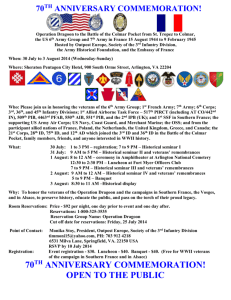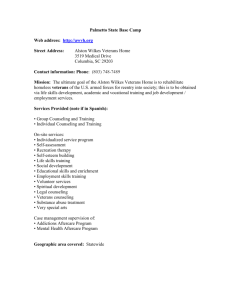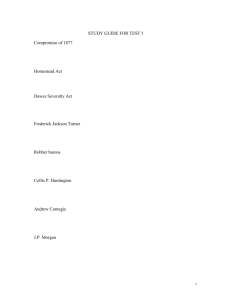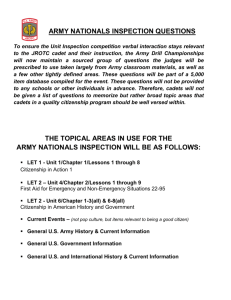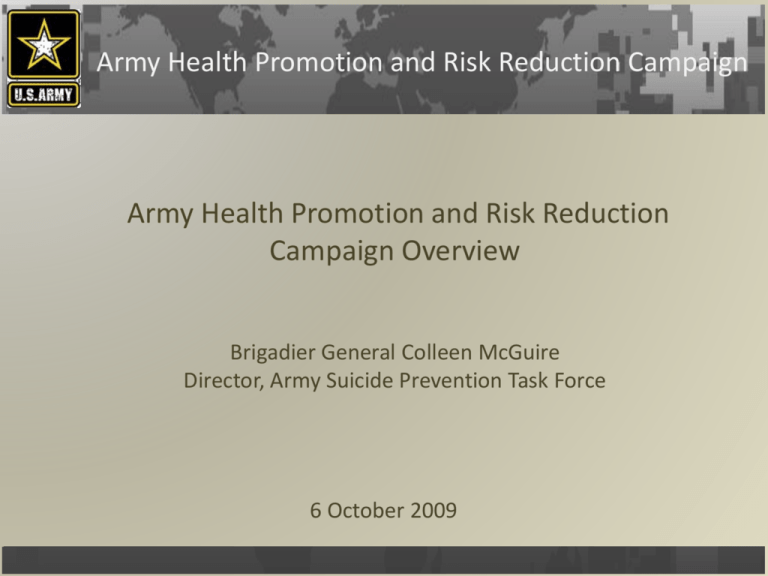
Army Health Promotion and Risk Reduction Campaign
Army Health Promotion and Risk Reduction Campaign
Army Health Promotion and Risk Reduction
Campaign Overview
Brigadier General Colleen McGuire
Director, Army Suicide Prevention Task Force
6 October 2009
Army Health Promotion and Risk Reduction Campaign
Changing Our Perspective
“The Army’s charter is more about improving the physical, mental,
and spiritual health of our soldiers and their families than it is about
suicide prevention. If we do the first, we are convinced that the second
will happen”
“Unfortunately, in a growing segment
of the Army's population, we have
seen increased stress and anxiety
manifest itself through high-risk
behavior, including acts of violence,
excessive use of alcohol, drug abuse,
and reckless driving"
2
Army Health Promotion and Risk Reduction Campaign
• Army suicide rate has been historically lower than the US population rate
• From 2001 to 2006, the “adjusted” US population suicide rate was steady at
19.5:100K while the Army rate doubled from 10:100K to 20.2:100K
25
22.3:100K (156/700K)
19.5:100K
Rate (per 100,000)
20
Civilian Rate
AD Army Rate
20.2:100K
15
10
5
Projected Active Duty Army Rate
Adjusted US Population Rate
Historic Active Duty Army Rate 10:100K
0
3
Army Health Promotion and Risk Reduction Campaign
Mission
Army Health Promotion, Risk Reduction Campaign (ACHP) is the means by which HQDA
will direct actions necessary to implement immediate and enduring policy solutions to
improve and immediately affect Army health promotion, risk reduction and suicide
prevention programs
Intent:
• Meet SA and CSA guidance to reduce Army suicide rate
• Analyze existing systems and processes for validity and redundancy
• Decrease stigma, change Army culture and create a rapid shift to socialize positive
attitudes toward effectively addressing behavioral health issues
• Ensure care systems are holistic and integrated
Actions:
• Established Army Suicide Prevention Task Force – 23 Mar 09
• Published ACPHP Campaign Plan - 16 Apr 09
4
Army Health Promotion and Risk Reduction Campaign
Cmd Tm &
Unit Leaders
Indications of Increasing Risk
• Infidelity
• Excessive alcohol use / abuse
• High risk driving
• Multiple drug use offenses
• Opiate-based drug misuse
• Sleep deprivation
• Erratic behavior
• UCMJ violations
• Extreme financial hardship
• Sexual / psychological abuse
No / Low
Risk
At-risk
Behaviors
Mitigation
Programs
Mitigation
• Relationship counseling
• Financial counseling and assistance
• Administrative separation
• Increased drug use testing
• Review for medical retirement
• Non-judicial punishment
• In-patient treatment
Moderate
Risk
High
Risk
Ideations
Gestures
Attempts
Completions
Intervention
Management
Postvention
Investigation
Outpatient Counseling
Inpatient Counseling
Hospitalization
Unit Postvention
5
Army Health Promotion and Risk Reduction Campaign
Assessment
Education /
Training
Interventions
Treatment
Low Resilience
High Resilience
Assessment
Silo’ed programs
“One size fits all”
General care
Reduced Intervention / Treatment
Develop / Refine /
Adjust / Divest
Integrate
Integrated programs
“Perfect fit”
Targeted care
Transformed Care
Legacy Programs
High Intervention / Treatment
ACPHP
Soldier Life-Cycle
Individual Soldier, Unit and Family Resiliency
Initial Entry Tng
CSF
Institutional Programs (Physical / Behavioral / Spiritual / Social…)
6
Army Health Promotion and Risk Reduction Campaign
Questions / Discussion
7
UNCLASS/FOUO
AMERICA’S ARMY:
THE STRENGTH OF THE NATION
Army G-3/5/7
COMPREHENSIVE SOLDIER FITNESS:
STRONG MINDS, STRONG BODIES
\
BG Rhonda Cornum
AS OF: 3/14/2016 2:40 AM
UNCLASS/FOUO
DAMO-CSF
8
UNCLASS/FOUO
AMERICA’S ARMY:
THE STRENGTH OF THE NATION
Army G-3/5/7
“… full spectrum operations—simultaneous offensive, defensive, and
stability or civil support operations—is the primary theme of this manual.”
FM 3-0, Operations (February 2008)
AS OF: 3/14/2016 2:40 AM
UNCLASS/FOUO
DAMO-CSF
9
UNCLASS/FOUO
AMERICA’S ARMY:
THE STRENGTH OF THE NATION
Army G-3/5/7
“We must also provide for our Families. We will not be
successful if we fail to care for our loved ones waiting for
their Soldiers to return. We must fight for their healthcare,
children, housing, and Well-Being with the same vigor we
fight with on the battlefield. They deserve nothing less.”
SMA Kenneth O. Preston – Sergeant Major of the Army
(December 2006)
UNCLASS/FOUO
DAMO-CSF
UNCLASS/FOUO
AMERICA’S ARMY:
THE STRENGTH OF THE NATION
CSF - What is it?
Army G-3/5/7
CSF is…
“A structured, long term assessment and
development program to build the resilience and
enhance the performance of every Soldier, Family
member and DA civilian.”
Gen George Casey, CSA
CSF is not…
Not just another mandatory training requirement
Not a “screen” for any physical or psychological disease or
dysfunction, including suicide
Not something we “do” after a Soldier, Family member, or DA Civilian
has a negative psychological, physical, social, or professional outcome
AS OF: 3/14/2016 2:40 AM
UNCLASS/FOUO
DAMO-CSF
11
UNCLASS/FOUO
AMERICA’S ARMY:
THE STRENGTH OF THE NATION
Comprehensive Soldier Fitness
Agenda
Army G-3/5/7
AS OF: 3/14/2016 2:40 AM
UNCLASS/FOUO
DAMO-CSF
12
UNCLASS/FOUO
AMERICA’S ARMY:
THE STRENGTH OF THE NATION
Initial Focus
Agenda
Army G-3/5/7
Priority of Effort
Focus initial efforts on Junior Enlisted:
Highest rate of PTSD, other BH problems (PDHA/PDHRA data)
Highest rate of financial problems
Highest rate of divorce, positive UA’s, Chapters
Greatest potential Positive impact on Force
All our Soldiers, Family
members, and Civilians are
Important!
AS OF: 3/14/2016 2:40 AM
UNCLASS/FOUO
DAMO-CSF
13
UNCLASS/FOUO
AMERICA’S ARMY:
THE STRENGTH OF THE NATION
Pillars of the Program
Army G-3/5/7
1. Self assessment tool (Global Assessment Tool)
Deploy to entire Force
Adapt to Family members
2. Self development modules queued by assessment
Civilian-Military working group in five dimensions – ensures
quality (Physical, Emotional, Social, Family, Spiritual)
Implement simultaneously with Assessment
On line and program training - available to Family members
3. Resilience training
All TRADOC schools; progressive, sequential
Unit Training - varies by deployment cycle
Will be offered at Family Forum events
4. Master Resilience Trainers (MRT)
Teaches Leaders to instill resilience in subordinates
Platoon, Company, Battalion level: “Soldiers Helping Soldiers”
Civilian Institution Immediate; TRADOC Long-term
MRTs at BN, Brigade and Installation level supporting Soldiers, Families, and
DA Civilians
AS OF: 3/14/2016 2:40 AM
UNCLASS/FOUO
DAMO-CSF
14
UNCLASS/FOUO
AMERICA’S ARMY:
THE STRENGTH OF THE NATION
1. Global Assessment Tool (1/3)
Army G-3/5/7
Type of Assessment:
Online survey via a secure website
Access via AKO
Number of questions: < 150 for Soldiers (pending for
Family members and DA Civilians)
Time required: >20,000 respondents, approximately 24
minutes
Who will take the GAT:
Army service members (Enlisted and Officer) to include
Reserves and National Guard
Army Family members and DA Civilians will have the
opportunity to take the GAT and participate in SelfDevelopment Modules in the future
AS OF: 3/14/2016 2:40 AM
UNCLASS/FOUO
DAMO-CSF
15
UNCLASS/FOUO
AMERICA’S ARMY:
THE STRENGTH OF THE NATION
Global Assessment Tool (2/3)
Army G-3/5/7
AS OF:
2:40
AMAM
AS
OF:3/14/2016
3/14/2016
2:40
UNCLASS/FOUO
DAMO-CSF
16
UNCLASS/FOUO
AMERICA’S ARMY:
THE STRENGTH OF THE NATION
Global Assessment Tool (3/3)
Army G-3/5/7
Emotional Fitness
Distribution
As of 1200 24 SEP 09
AS OF: 3/14/2016 2:40 AM
UNCLASS/FOUO
Emotional Results to date
Mean
Min
Max
All Army
3.72
1.1
5.0
E1-E4
3.56
1.1
5.0
E6-E9
3.78
1.6
5.0
O1-O3
3.85
2.1
4.9
O6-O10
3.98
1.8
4.8
Females
3.74
1.6
4.9
Males
3.68
1.1
5.0
DAMO-CSF
17
UNCLASS/FOUO
AMERICA’S ARMY:
THE STRENGTH OF THE NATION
2. Resilience Training
Army G-3/5/7
Develop critical thinking, knowledge, and skills to
overcome challenges, mature, and bounce back from
adversity
All training is evidenced based
Future curriculum development will be based on
demonstrated quality, efficacy, and lessons learned
Teaches people to see that:
Challenges are temporary - not permanent
Challenges are local - not pervasive
Challenges can be changed by your own effort
AS OF: 3/14/2016 2:40 AM
UNCLASS/FOUO
DAMO-CSF
18
UNCLASS/FOUO
AMERICA’S ARMY:
THE STRENGTH OF THE NATION
3. Self-Development
Army G-3/5/7
Soldiers, Family members, and DA Civilians directed to a
menu of self-development modules based on results from
GAT.
Provides evidence-based training in each area of health
available based on individual needs
Offered on line to all Army Components and deployed
Soldiers, Family members, and DA Civilians
Military and civilian expert workgroups determined the
knowledge, skills and attributes for each dimension
Will utilize technology to integrate outcomes; results
inform decisions on which programs to continue to support,
expand, or eliminate
AS OF: 3/14/2016 2:40 AM
UNCLASS/FOUO
DAMO-CSF
19
UNCLASS/FOUO
AMERICA’S ARMY:
THE STRENGTH OF THE NATION
Resilient Mental Skills
Army G-3/5/7
Real-time Resilience: Shut down counter-productive thinking to enable greater
concentration and focus on the task at hand.
Problem Solving: Increase flexibility and accuracy in thinking about the causes
of problems to improve problem solving.
Put It In Perspective: Stop worst case scenario thinking, reduce anxiety, and
improve problem solving by identifying the Worst, Best, and Most Likely
outcomes of a situation.
Energy Management: Build emotion regulation, increase positive emotions and
mental fitness.
Avoid Thinking Traps: Identify and correct recurrent counter-productive
patterns in thinking through the use of Critical Questions.
Detect Icebergs: Identify and evaluate deep beliefs and core values that fuel
out-of-proportion emotion and evaluate the accuracy and usefulness of these
beliefs.
ABC: Identify your Beliefs about an Activating Event and the Consequences of
those Beliefs.
(Copyright 2009 The Trustees of the University of Pennsylvania. All rights reserved).
UNCLASS/FOUO
DAMO-CSF
UNCLASS/FOUO
AMERICA’S ARMY:
THE STRENGTH OF THE NATION
Strength and Relationship Skills
Army G-3/5/7
Identifying Strengths in Self and Others: Use the VIA Strength Survey to
identify one’s top strengths and learn how to identify strengths in others.
Strengths in Challenges: Learn how to use one’s strengths to meet a
challenge or overcome an adversity, both as an individual and as part of a
team.
Active Constructive Responding: Learn a system of responding to others
that builds positive relationships and strengthen bonds.
Praise: Learn how to praise effectively to build mastery and “winning streaks”.
Assertive Communication: Learn how to communicate clearly and with
respect focusing on the 4 C’s: Calm, Confident, Clear, Controlled.
(Copyright 2009 The Trustees of the University of Pennsylvania. All rights reserved).
UNCLASS/FOUO
DAMO-CSF
UNCLASS/FOUO
AMERICA’S ARMY:
THE STRENGTH OF THE NATION
4. Master Resilience Training
Army G-3/5/7
Increase core competencies such as optimism, mental agility, and self-regulation
“Soldiers helping Soldiers” and “Families helping Families”
Modify University of Pennsylvania materials to Soldier, Family member, and DA
Civilian populations
Level I
10 day course
Master Resilience Trainer
Level 1 trained;
additional 2 weeks training
Level II
AS OF: 3/14/2016 2:40 AM
UNCLASS/FOUO
DAMO-CSF
25
22
UNCLASS//FOUO
AMERICA’S ARMY:
THE STRENGTH OF THE NATION
CSF Roll Out Timeline
Agenda
Army G-3/5/7
Roll Out Objectives:
1. GAT – All non-deployed Soldiers
complete by March 2010
2. SD – Fielded concurrent to GAT and
cohort specific
3. MRT – 1800 trained in first year
1st MRT
Course
GAT for
Army Civilians
Online
TRADOC
IOC of MRT
Course
GAT for
Families
Online
GAT for
Soldiers
Online
Initial GAT
Review
1st MRTFacilitator
Course
AS OF: 19 September 2009
UNCLASS//FOUO
DAMO-CSF
Legend:
1. GAT – Global Assessment Tool
2. SD – Self Development Module
3. MRT – Master Resilience Trainer
4. IOC – Initial Operating Capability
23
UNCLASS/FOUO
AMERICA’S ARMY:
THE STRENGTH OF THE NATION
Army G-3/5/7
Will it Work?
Does it Matter?
AS OF: 3/14/2016 2:40 AM
UNCLASS/FOUO
DAMO-CSF
24
UNCLASS/FOUO
AMERICA’S ARMY:
THE STRENGTH OF THE NATION
Navy Resilience Study (1/2)
Agenda
Army G-3/5/7
Day 1
Day 3
Day 4
9 Week
Basic
Training
Results?
Upper 75%
Normal
Training
?
Normal
Training
?
Assessment
Recruits
(Depression,
Perceived Stress,
Loneliness,
Coping Style)
Lower 25%
Normal Training
Additional 45 min/
week of Group
Resilience Training
?
Williams, 2004
AS OF: 3/14/2016 2:40 AM
UNCLASS/FOUO
DAMO-CSF
25
UNCLASS/FOUO
AMERICA’S ARMY:
THE STRENGTH OF THE NATION
Navy Resilience Study (2/2)
Agenda
Army G-3/5/7
Williams, 2004
AS OF: 3/14/2016 2:40 AM
UNCLASS/FOUO
DAMO-CSF
26
UNCLASS/FOUO
AMERICA’S ARMY:
THE STRENGTH OF THE NATION
Treat Risk vs Enhance Strength
Army G-3/5/7
Navy Resilience Study
Lower 25%
Comprehensive Soldier Fitness
AS OF: 3/14/2016 2:40 AM
UNCLASS/FOUO
DAMO-CSF
27
UNCLASS/FOUO
AMERICA’S ARMY:
THE STRENGTH OF THE NATION
Army G-3/5/7
DISCUSSION
AS OF: 3/14/2016 2:40 AM
UNCLASS/FOUO
DAMO-CSF
28
Veterans Benefits Administration
Presentation for:
AUSA
Mike Carr
Veterans Benefits Administration
Office of Policy and Program Management
October 2009
Veterans Benefits Administration
29
Veterans Benefits Administration
Compensation and Pension
Education
Loan Guaranty
Insurance
Vocational Rehabilitation and Employment
Veterans Benefits Administration
30
VBA Regional Offices
Manchester
Seattle
Ft. Harrison
Fargo
Portland
St.
Paul
Boise
Boston
Milwaukee
Sioux Falls
Cheyenne
Lincoln
Salt Lake
City
Buffalo
Pittsburgh
Providence
Hartford
New York
Huntington
Newark
Philadelphia
Wilmington
Detroit
Des Moines
Cleveland
Chicago
Reno
Oakland
Indianapolis
Denver
St. Louis
Baltimore
Wichita
DC
Roanoke
Louisville
Los Angeles
Winston Salem
Nashville
Albuquerque
San Diego
Togus
White River Jct.
Muskogee
Little
Rock
Columbia
Atlanta
Montgomery
Phoenix
Waco
Jackson
New Orleans
Honolulu
Houston
Anchorage
Veterans Benefits Administration
St. Petersburg
Regional Office (RO)
RO & Education Regional Processing Center (RPO)
RO & Regional Loan Center (RLC)
RO, RPO & RLC
RO & Insurance Center
31
San Juan
In-Service VA Benefits
VA Benefits for those serving on active duty:
–
–
–
–
–
–
Home Loan Guaranty
Education Services
Servicemembers’ Group Life Insurance
Traumatic Servicemembers’ Group Life Insurance
Allowance for Adapting an Automobile
Special Adaptive Housing Grant
Services available 180 days prior to separation
– Pre-discharge Services
– Coming Home to Work
– Vocational and Educational Counseling
Veterans Benefits Administration
32
Pre-Discharge Services
Benefits Delivery at Discharge (BDD)
Quick Start
Disability Evaluation System (Pilot)
Seriously Injured/Very Seriously Injured
BDD and Quick Start Claims processing is available at all
locations where VA excepts claims to include Veterans Online
Application
Veterans Benefits Administration
33
VBA Outreach Programs
Military Outreach
–
–
–
–
–
Transition Assistance Briefings
Disability Transition Assistance Briefings
Yellow Ribbon Reintegration Briefings
Retirement and Family Day Events
Coming Home to Work
Targeted Outreach
New Media Outreach
Veterans Benefits Administration
34
Post-9/11 GI Bill Eligibility Criteria
Service Requirements
(after 9/10/01 serve an aggregate of)
36 months
30 continuous days
% of Maximum
Benefit Payable
100
100
(Must be discharged with a disability)
30 months, but less than 36 months
90
24 months, but less than 30 months
80
18 months, but less than 24 months
70
12 months, but less than 18 months
60
06 months, but less than 12 months
50
90 days, but less than 06 months
40
Veterans Benefits Administration
35
Post-9/11 GI Bill
In general, individuals will remain eligible for
benefits for 15 years from:
– Date of last discharge; or
– Release from active duty of at least 90
continuous days.
Individuals will generally receive 36 months of
benefits.
Individuals are limited to 48 months of
combined benefits under educational assistance
programs administered by VA
Veterans Benefits Administration
36
Post-9/11 GI Bill Benefit Payments
Tuition and Fees Charged
Monthly Housing Allowance
Stipend for Books and Supplies
Note: All VA Regional Offices began issuing
emergency payments effective October 2, 2009
Veterans Benefits Administration
37
Yellow Ribbon Program
IHLs may voluntarily enter into an agreement with
VA to pay tuition and fees charged that are not
covered under Post 9/11 Chapter 33.
VA will match each additional dollar funded by the
school.
The combined amounts may not exceed the full cost
of the school’s tuition and fees charged.
Only individuals entitled to the 100% benefit rate
(based on service requirements) may receive this
funding.
Veterans Benefits Administration
38
Veterans Benefits Administration
Questions?
Compensation & Pension:
Loan Guaranty:
Insurance:
Vocational Rehabilitation:
Education:
800.827.1000
800.244.6711
800.669.8477
800.827.1000
888.442.4551
Website Location: www.va.gov
Veterans Benefits Administration
39
Department of Veterans Affairs
Care Management and Social Work
Service
Jennifer Perez, LICSW, Acting Chief Consultant
Care Management and Social Work Service,
Office of Patient Care Services,
Department of Veterans Affairs Central Office
Department of Veterans Affairs
Veterans Health Administration
– VA Medical Centers (VAMC), Community
Based Outpatient Clinics (CBOC), Vet Centers
Veterans Benefits Administration
– Compensation, Pension, Vocational
Rehabilitation, Home, Loan Guarantee, etc.
Veterans Cemetery Administration
– Maintains national cemeteries across the
country
VHA Map
IN JANUARY 2002
VISNS 13 AND 14
WERE INTEGRATED AND
RENAMED VISN 23
VA System of Care
153 Hospitals
Over 900 Ambulatory Care and Community Based
Outpatient Clinics
232 Vet Centers – Readjustment Counseling Centers
– also treats family
Women’s Health Program
Spinal Cord Injury Rehab (SCI)
Blind Rehab Centers (BRC) – VIST, BROS, etc.
Residential/Inpatient/Outpatient PTSD Programs
Polytrauma Rehab Centers (PRCs)
Polytrauma Network Site (PNS)
Polytrauma Support Clinical Teams (PSCT)
In-Home Care
Prosthetics and Sensory Aids
Healthcare for Homeless Veterans
Any many more….
Care Management and Social
Work Service
October 2007 VHA established Care Management and Social
Work Service (CM/SWS)
Addressing the needs of wounded and ill service members and
Veterans as well as
Expanding the role of Social Work programs within VHA
CM/SWS is part of the Office of Patient Care Services and has
responsibility for five national programs:
– VA Liaison Program
– OEF/OIF Care Management Program
– National Social Work Program
– Caregiver Support Program
– Family Hospitality Program (Temporary Lodging & Fisher
Houses)
VA Liaisons for Healthcare
VA & DoD partnership began in
August 2003
31 social workers and nurses
working as VA Liaisons in 17
Military Treatment Facilities
(MTFs)
Integrated with staff at the
MTF to coordinate health care
and provide onsite
consultation/collaboration
about VA resources and
treatment options
VA Liaisons for Health Care Assigned to
Military Treatment Facilities
Ft. Lewis
1 VA Liaison
1 VA Liaison
3 VA Liaisons
Ft. Drum
1 VA Liaison
1 VA Liaison
5 VA Liaisons
NNMC
Ft. Carson
WRAMC
1 VA Liaison
Ft. Riley
Ft. Knox
Ft. Eustis
Ft. Campbell
2 VA Liaisons
Ft. Bragg
(RECRUITING)
2 VA Liaisons
1 VA Liaison
Ft. Gordon
2 VA Liaisons
Ft. Benning
Ft. Hood
Ft. Bliss
Ft. Stewart 1 VA Liaison
Ft. Sam Houston
1 VA Liaison
Camp
Pendleton
Balboa
2 VA Liaisons
2 VA Liaisons
1 VA Liaison
1 VA Liaison
4 VA Liaisons
**Newly established sites due to expansion of program
VA OEF/OIF Care Management Teams
OEF/OIF Program Manager
– Serves as POC for referrals from MTF; coordinates
clinical care and oversees transition and care for
OEF/OIF service members and veterans; assigns case
managers and Transition Patient Advocates
OEF/OIF Case Manager
– Provides case management services to Severely
Ill/Injured patients and to those identified in need of
case management
Transition Patient Advocate (TPA)
– Serves as an advocate across episodes and sites of
care for patients who are severely ill/injured
Family Hospitality Program
(Temporary Lodging and Fisher Houses)
Outreach
www.oefoif.va.gov
Call Center
Annual Welcome Home events
PDHRA, Yellow Ribbon
Readjustment Counseling Service...
Celebrating 30 Years in Service to our Nations Veterans
…Keeping the Promise
Alfonso R. Batres, Ph.D.
Chief Officer
Readjustment Counseling Service
WWII American Theater
Campaign Medal
WWII Asian Pacific
Campaign Medal
WWII European, African, Middle
Eastern Campaign Medal
WWII Victory Medal
Korea Service Medal
Armed Forces Expeditionary Medal
Vietnam Service Medal
SW Asia Service Medal
Kosovo Service Medal
GWOT Expeditionary Medal
Afghanistan Campaign Medal
Iraq Campaign Medal
USMC Combat Action Ribbon
USMC Expeditionary Medal
Navy Expeditionary Medal
Readjustment Counseling Service...
Celebrating 30 Years in Service to our Nations Veterans
…Keeping the Promise
Mission Statement
We are the people in VA who welcome home
war Veterans with honor by providing
readjustment counseling in a caring manner.
Vet Centers understand and appreciate
Veterans’ war experiences while assisting them
and their family members toward a successful
post-war adjustment in or near their
community.
Readjustment Counseling Service...
Celebrating 30 Years in Service to our Nations Veterans
…Keeping the Promise
Vet Centers:
• Vet Center services do not require enrollment in the
larger VA system. Eligibility is based on service
in a combat theater of operations, sexual
trauma while on active duty, or loss of a family
member who was serving on active duty.
• Vet Centers have eligibility to see families for military
related problems.
•Vet Centers are in Veteran and family friendly, easy to
access locations outside of VA hospitals.
Readjustment Counseling Service...
Celebrating 30 Years in Service to our Nations Veterans
…Keeping the Promise
Vet Centers:
• Vet Centers are confidential and safe environments
where services can be provided.
•Vet Centers have trained mental health providers, most
of them Veterans themselves, who understand
and respect military services and the role families
play.
• Over 60% of Vet Center direct counseling staff are
licensed psychologists, licensed social workers,
or licensed psychiatric nurses.
Readjustment Counseling Service...
Celebrating 30 Years in Service to our Nations Veterans
…Keeping the Promise
Vet Centers:
• Over 42% of Vet Center staff are women.
• Over 18% of Vet Center staff are women Veterans,
with over 10% having served in a combat theater
of operations.
• Vet Centers currently have over 120 qualified family
counselors on staff. All Vet Centers will have a
qualified family counselor in the near future.
Readjustment Counseling Service...
Celebrating 30 Years in Service to our Nations Veterans
…Keeping the Promise
Vet Centers:
• 28 new Vet Centers have been authorized to be
established in 2010 bringing the total to 299.
• Vet Centers are located in all 50 States, District of
Columbia, Puerto Rico, Guam, American Samoa
(in 2010) and the American Virgin Islands.
Readjustment Counseling Service...
Celebrating 30 Years in Service to our Nations Veterans
…Keeping the Promise
Services:
Readjustment counseling is a wide range of psycho social services
offered to eligible Veterans and their families in the effort to make a
successful transition from military to civilian life.
Services offered at Vet Centers nationwide include:
• Counseling for Veterans and their families
• Marital & family counseling for military related issues
• Bereavement services.
• Military sexual trauma counseling and referral
• Demobilization outreach and services
• Substance abuse assessment and referral
• Employment assessment & referral
• VHA screening & referral
• VBA screening & referral
• Veterans community outreach and education
Readjustment Counseling Service...
Celebrating 30 Years in Service to our Nations Veterans
…Keeping the Promise
Vet Centers:
•
Vet Centers have provided family services for
military related issues since the program’s
inception in 1979.
Readjustment Counseling Service...
Celebrating 30 Years in Service to our Nations Veterans
…Keeping the Promise
OEF/OIF Family Services
3,500
3,000
2,500
2,000
1,500
1,000
500
0
OEF/OIF Families
2005
2006
2007
2008
1,187
1,981
2,443
3,127
Readjustment Counseling Service...
Celebrating 30 Years in Service to our Nations Veterans
…Keeping the Promise
On August 5, 2003, the VA Secretary authorized
Vet Centers to furnish bereavement counseling
services to surviving parents, spouses, children
and siblings of service members who have
fallen while on active duty, to include federally
activated Reserve and National Guard
personnel.
Readjustment Counseling Service...
Celebrating 30 Years in Service to our Nations Veterans
…Keeping the Promise
The Vet Center bereavement program
was developed and completely vetted
through the Department of Defense.
Vet Center referrals for bereavement
counseling come directly from the
Casualty Assistance Officers.
Through August 2009, the Vet
Centers have assisted the
families of 1,656 fallen Service
Members, 1,160 (70%) were
in-theater casualties in Iraq or
Afghanistan.
Readjustment Counseling Service...
Celebrating 30 Years in Service to our Nations Veterans
…Keeping the Promise
Over 15,958 bereavement visits
have been provided by Vet
Center staff, many times in the
family’s home. This is an
average of 9.6 visits per family.
Of all the family members served:
36% are Mothers
22% are Spouses
17% are Fathers
14% are Siblings
11% are Children
Wayne Boswell
Quality of Life Chief,
HQ EUCOM J1
&
Shawn Moon
General Manager for
Government Services,
FranklinCovey
6 October 2009
EUCOM’s 2007 Deployment & Community
Counseling Support Conference
Issue
To prevent caregiver burnout, EUCOM leadership needs to create and implement a
comprehensive Compassion Fatigue Program (CFP)
Description
Caregivers (to include chaplains, medical providers, Family support staff, DoDDS-E
counselors, FRG leaders, Rear Detachment CDRs, key volunteers…) are at high risk for
burnout physically, emotionally, mentally and spiritually
Currently, there is insufficient dedicated funding for caregiver programs
“Regular exposure to trauma and terrible knowledge about life can deeply affect
staff's emotional, behavioral, and spiritual well-being in painful and unsettling
ways. Although general work stress is frustrating, secondary traumatic stress
can, over time, change people forever”
Dr. Roger Friedman, Ph.D. U of M, School of Social Work
Recommendation
Create & implement a comprehensive Compassion Fatigue Program to prevent
caregiver burnout
POWER Program
•Developed strategy with caregivers at EUCOM’s Deployment and Community
Counseling Conference in Jun 08
•EUCOM Beta Tested POWER Program in Sep 08
•EUCOM and ERMC partnered to provide over $400K for facilitator and caregiver
training and materials
•EUCOM conducted second Beta in Jul 09
•Components hosted 3-day Train the Trainer certification course with 25
facilitators per session
• 26-28 August- Bamberg, Germany
• 1-3 September- Lakenheath, UK
• 9-11 September, Aviano, Italy
•15-17 September, Naples, Italy
• 23-25 September, Kaiserslautern, Germany
• Late Winter FY2010, Location TBD
•Trainers/Facilitators provided materials to train 35 caregivers
•By the end of FY10, over 5K caregivers will have received the POWER program
POWER program objectives
Individuals will:
• Assess their personal level of compassion satisfaction,
compassion fatigue and burnout via an online assessment
• Increase understanding of compassion fatigue
• Build a list of skills they can use to alleviate burnout
• Create an action plan to build self-care habits
• Learn skills to improve their professional quality of life
through strengthening work-life balance
• Focus on taking care of themselves
• Develop a resiliency action plan
• Recognize other caregivers who need support
Certification Process for Trainers
Day 1 – (Same for Trainers & Caregivers)
•
Introduction (What’s In It For Me and Common Definitions)
•
Assess (Professional QoL Assessment & Compassion Fatigue
Markers)
•
Educate (Resiliency Skills for Self Care)
•
Plan (Focus on Important Tasks and Resiliency Action Plan)
DAY 2 (Trainers Only)
•
Small Group Facilitation Review and Practice Exercises
DAY 3 (Trainers Only)
•
Practice Facilitation
•
Enhance Facilitation Techniques
•
Additional Facilitator Resources (Yearly Facilitator
Enhancement Day, Monthly E-mails, Blog, Facilitator
Network Community)
Participant Feedback
“POWER is liberating-- to know it’s ‘okay’ to take care of yourself.” – Airman and Family
Readiness, Community Readiness Technician, Aviano, IT
“I was really excited to attend this program where the approach was so much different. It
made it something that not only fit into my life but promoted better care of the people who are
important to me; my patients and my Family. It made me realize how much better a provider I
would be if I did the things that I commit to, to take care of myself. It also provided me with
very concrete ways to fit that into my schedule and some follow-up to ensure I do it.” – ASAP
Counselor, Grafenwoehr
“I will be taking this back to FRGs, and more importantly to our Rear Detachment personnel
and Casualty Care Teams…The program is beneficial to Family members of Soldiers,
Soldiers in the rear taking care of Families and Soldiers in leadership positions who are
taking care of other Soldiers and it’s important that we focus on them taking care of
themselves to be able provide that care giving and this course will help them do that.” – ACS,
Mobilization & Deployment Specialist, Grafenwoehr
“I’ve known for a long time about resiliency and the need to take care of myself and that’s
what resiliency is all about. Knowing the pieces is one thing but putting it all together as a
whole is another…it put it all together. You have a little piece of knowledge from here and
there but until you put it all together it’s not as beneficial. It’s going to changed my attitude
toward work and what I’m doing how I feel about what I’m doing.” – LCSW, LRMC

